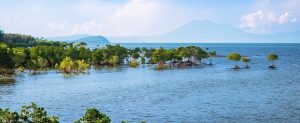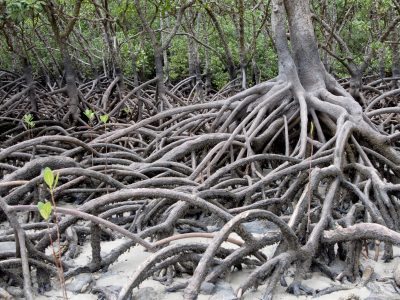Mangroves from a Geomorphologist Perspective
Before arriving in Baton Rouge to commence graduate studies at Louisiana State University in late 1962, I attended a lecture in Sydney by a mangrove ecologist named Bill Macnae. He was a South African visiting Australian mangrove locations. It was one of the inspired occasions hearing not just about his observations here, but how he interpreted patterns of mangrove species zonation based on his reading of the epic 1928 study by J. G. Watson on Mangrove Forests of the Malay Peninsula (published in Malayan Forest Records No 6). I managed to obtain a copy of this publication which I still treasure. One phrase struck me “that mangroves follow silting rather than cause it”.
This interest in mangroves allowed me to be associated with a team from the Coastal Studies Institute (CSI) at LSU to go to Tabasco in southern Mexico for several months in mid-1963. Bob West, our leader, also had a fascination for mangroves, but his interests were much broader as part of a regional geographic analysis of this deltaic area. Before departing he engaged me as a research assistant to read about mangroves and other ecological literature. With Macnae and Watson behind me it was an opportunity to look at the veracity of the more accepted concept of mangrove succession with mangroves as the causative agent in the land forming process from a pioneer stage through to a non-mangrove forest.
I soon became aware of several studies by ecologists (on occasions in association with soil scientists and geomorphologists) examining the relationship between landforms and vegetation. This enabled me to develop a conceptual model to test in Tabasco whereby the distribution of plants is a function of habitat change induced by geomorphic processes independent of biotic factors. I had the advantage of being based in southern Louisiana in a group who had dedicated their careers to studying active processes of sedimentation in a diverse deltaic system. It was not difficult to think how an understanding microtopographic form could help explain patterns of plant distribution especially when confronted as I was in Tabasco with a deltaic system driven by river channel development and abandonment similar to that of the Mississippi Delta.
This study became one of several over the next 10 years involving myself and others on the distribution of vegetation in terms of present relations of component species to environments where environments are defined to a large degree by geomorphic processes acting over time. In 1971, I visited the Ord delta region with another CSI team from LSU involving Don Wright. The environmental setting was very different from Tabasco: macro not micro tidal; monsoonal dry not wet; stable sea level not subsiding lowlands. Again, it was possible to test a conceptual model of evolving landforms and changing mangrove patterns. This work was reinforced by work with Colin Woodroffe and John Chappell in the South Alligator River area in 1984 where we found similar indications of a vast mangrove cover of tidal flats (“The Big Swamp”) which retreated under a vertical accreting surface after sea level stabilized around 6000 years ago. Although not formally engaged in mangrove studies on the northern Great Barrier Reef expedition of 1973, it was apparent that mangrove species distributions there are closely aligned to topographic units.
I have been very fortunate to have encountered mangroves in different places, and in turn worked with others who have made huge contributions to mangrove ecology. It is now the subject of intense interest as part of the emerging growth of the “blue economy”. I feel very privileged to have helped others. If any reader would like to know more about my mangrove studies, please contact me. In the meantime I will leave you with a little poem and apologies to Joyce Kulmer (1886-1918).
I think that I shall never see,
mangroves lovely as a tree;
a tree whose hungry mouth is salt;
living with tides flowing free.
A tree that looks for sun to shine,
and lifts her leafy arms to soak,
those rays of light year-round,
and offer life to all abound.
Bruce Thom
Words by Prof Bruce Thom. Please respect the author’s thoughts and reference appropriately: (c) ACS, 2023. For correspondence about this blog post please email admin@australiancoastalsociety.org.au
#239



 Complex Disasters: Compounding, Cascading and Protracted
Complex Disasters: Compounding, Cascading and Protracted